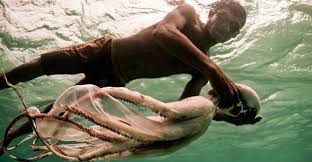‘Sea Nomads’ Are First Known Humans Genetically Adapted to Diving

For hundreds of years, the Bajau have lived at sea, and natural selection may have made them genetically stronger divers.
IF YOU HOLD your breath and plunge your face into a tub of water, your body automatically triggers what’s called the diving response. Your heart rate slows, your blood vessels constrict, and your spleen contracts, all reactions that help you save energy when you’re low on oxygen.
Most people can hold their breath underwater for a few seconds, some for a few minutes. But a group of people called the Bajau takes free diving to the extreme, staying underwater for as long as 13 minutes at depths of around 200 feet. These nomadic people live in waters winding through the Philippines, Malaysia, and Indonesia, where they dive to hunt for fish or search for natural elements that can be used in crafts.
Now, a study in the journal Cell offers the first clues that a DNA mutation for larger spleens gives the Bajau a genetic advantage for life in the deep.
Leaning on the Spleen
Of all the organs in your body, the spleen is perhaps not the most glamorous. You can technically live without it, but while you have it, the organ helps support your immune system and recycle red blood cells.
“I wanted to first meet the community, and not just show up with scientific equipment and leave,” she says of her initial travels to Indonesia. “On the second visit, I brought a portable ultrasound machine and spit collection kits. We went around to different homes, and we would take images of their spleens.
“I usually had an audience,” she adds. “They were surprised I had heard of them.”
She also took data from a related group of people called Saluan, who live on the Indonesian mainland. Comparing the two samples back in Copenhagen, her team found that the median size of a Bajau person’s spleen was 50 percent bigger than the same organ in a Saluan individual.
“If there’s something going on at the genetic level, you should have a certain sized spleen. There we saw this hugely significant difference,” she says.
The researchers also stumbled across a gene called PDE10A, which is thought to control a certain thyroid hormone, in the Bajau but not the Saluan. In mice, the hormone has been linked to spleen size, and mice that are manipulated to have lower amounts of the hormone have smaller spleens.
Llardo theorizes that over time, natural selection would have helped the Bajau, who have lived in the region for a thousand years, develop the genetic advantage.
While the spleen might partially explain how the Bajau dive so well, other adaptations may be at play, too, says Richard Moon from the Duke University School of Medicine. Moon studies how the human body responds to both high altitudes and extreme depths.
As a human dives deeper into the water, the increase in pressure causes the lung’s blood vessels to fill with more blood. In extreme cases, the vessels can rupture, causing death. In addition to genetically inherited adaptations, regular training could help prevent that effect.
“The lung chest wall could become more compliant. There could be some looseness that develops over your training. The diaphram could become stretched. The abs could become more compliant. We don’t really know if those things occur,” he says. “The spleen is able to contract to some extent, but we don’t know of any direct connection between thyroid and spleen. It may well be.”
Cynthia Beall is an anthropologist from Case Western Reserve University who has studied people living in extremely high altitudes, including Tibetans said to live at the “roof of the world.” She thinks Llardo’s study opens up interesting research opportunities but needs to see more measurable biological evidence before she’s convinced that a genetic trait is helping the Bajau become better divers.
“You could measure the spleen more, for example, strength of contractions of the spleen,” she says.
What Can We See From the Sea?
In addition to understanding how the Bajau became such good free divers, Llardo says the findings have medical implications.
The dive response is similar to a medical condition called acute hypoxia, in which humans experience a rapid loss of oxygen. The condition is often a cause of death in emergency rooms. Studying the Bajau could effectively act as a new laboratory for understanding hypoxia.
However, the sea nomad lifestyle is increasingly under threat. They’re considered marginalized groups that don’t enjoy the same citizenship rights as their mainland counterparts. Increased industrial fishing is also making it harder for them to subsist on local stocks. As a result, many choose to leave the sea.
Without support for their way of life, Llardo worries that the Bajau and the lessons they can impart about human health may not be around for much longer.





